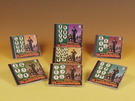Flamenco is a Spanish musical genre with origins in Andalusia and a term that refers both to a musical genre, known for its intricate rapid passages, and a dance genre characterized by its audible footwork. The origins of the term are unclear. The word Flamenco, which applies to the song, the dance and the guitar, did not come into use until the 19th century.
Flamenco embodies a complex musical and cultural tradition. Although considered part of the culture of Spain, flamenco actually originates from one of Spain's regions: Andalusia. However, other areas, mainly Extremadura and Murcia, have contributed to the development of several flamenco musical forms, and a great number of renowned flamenco artists have been born in other territories of the country. It is generally acknowledged that flamenco grew out of the unique interplay of native Arabic, Andalusian, Sephardic, and Gypsy cultures that existed in Andalusia prior to and after the Reconquest. Latin American and especially Cuban influences have also been important in shaping the rumba flamenco form. Flamenco is the music of the gypsies and played in their social community. Andalusian people who grew up around gypsies and the life were also accepted as "flamencos" (Paco de Lucía).
Flamenco
Flamenco Opera
Flamenco show: singing, dancing and guitar. Very common between 1920 and 1936 around Spain. Generally performed in bullfighting squares and huge theaters.
Flamenco Scene (Cuadro flamenco)
A group of dancing performers, singing and flamenco "toque".
Flamencología, Flamencology
Flamencology, from the Spanish word Flamencología, is an academic discipline pertaining to the Flamenco arts. It combines research, documentation, and other techniques to achieve the diffusion and preservation of the art. First use in 1955.
Floreo
Ornament realised in the singing and in the "toque". Circular movement of a leg, slightly high during the dance.
Free styles Compas (ad libitum)
Cartageneras, natural Fandangos, Granaínas, Medium Granaínas, Malagueñas, Milongas, Mineras, Tarantas. Songs without guitar accompaniment: Carceleras, Debla, Martinete, Pregón, Saeta, Toná, Trilla.
Galeras
It is a flamenco palo, musical style of singing and Spanish dancing. Created by Juan Peña "El Lebrijano" with its fundation in the buleria. It is not a very extended folk song among other singers.
Garrotín, The
The garrotin is a kind of flamenco song, coming from Asturias and its folklore.
Porbably originated by the Catlonian gipsies, with its fundations in the tango compas. This song is accompanied by a dance and its peak period is at the begining of XX. Century.
Giliana
A very primitive flamenco style. The gypsies sung this kind of songs during their private meetings. With a light solea compas or solea por bulerias, created on the "Romances Gitanos" (Gypsy Romance) during the Middle Age.
Golpe
Flamenco guitar technique, when you bang/beat the top of the guitar, in the upper part of the baseboard or on the "golpeador".



